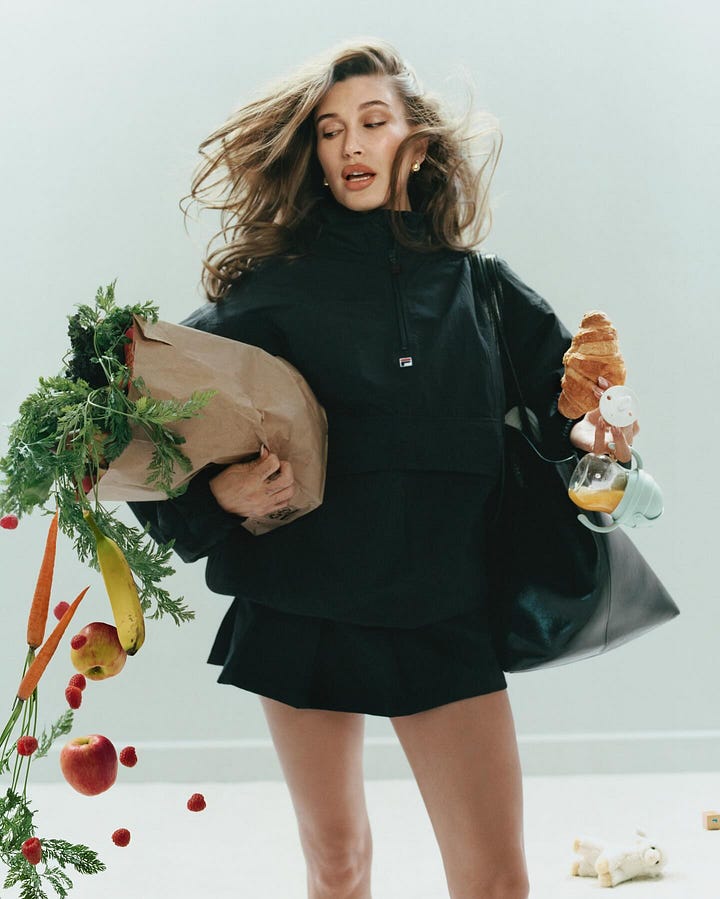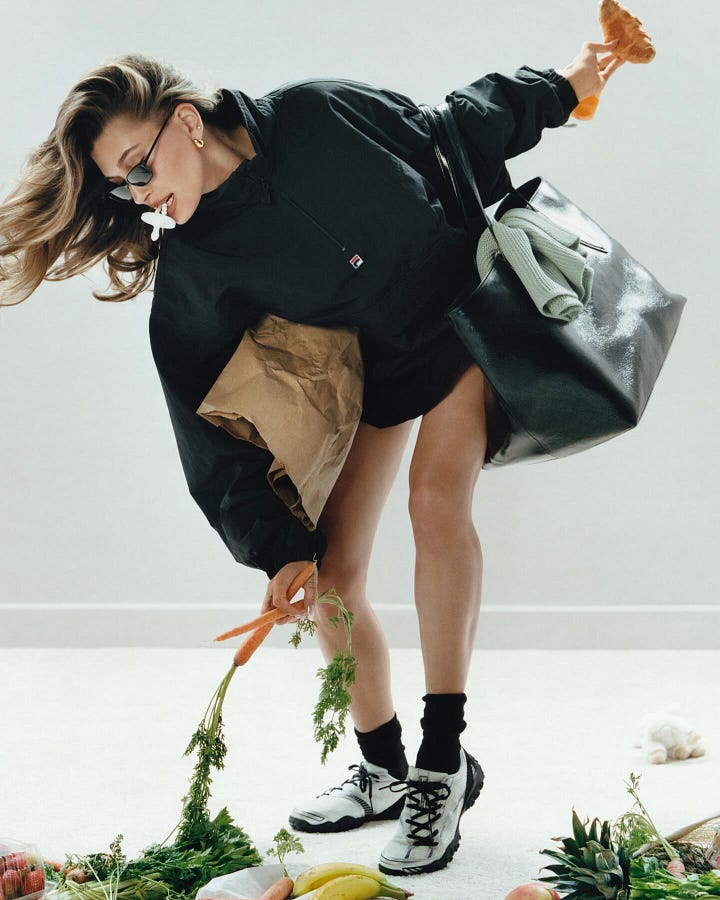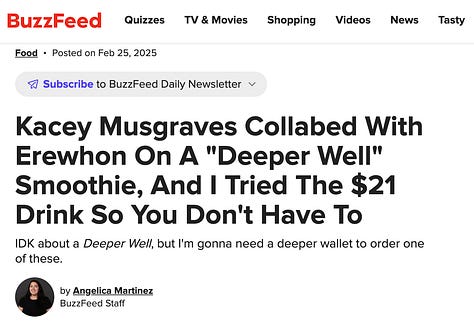how food became the new designer bag
The three-year Birkin waitlist? So last decade. Now, wealth whispers through $22 smoothies and artisanal grocery bags overflowing with expensive produce. Food has become the ultimate status signal.
Food isn’t just food anymore—it’s a flex, a vibe, a personal brand statement. What’s on your plate says as much about your social standing as what’s in your bank account (maybe even more, considering how much you just dropped on limited-edition Maldon salt).
exhibit A: hailey bieber + FILA


In a single FILA campaign, Hailey Bieber carried:
A perfectly imperfect croissant
A baby bottle (?)
Fresh produce casually spilling from a paper bag
The message? "I don’t care, but you know I care." It’s the culinary equivalent of “I woke up like this.” The grocery run aesthetic is now the ultimate lifestyle flex—because anyone can buy luxury, but only a select few know which groceries signal taste.
exhibit B: rihanna
Rihanna dipping a McNugget in caviar and calling it “soccer mom snacks” was not just a moment—it was a masterclass in high-low luxury flexing.
It’s not just about caviar—it’s about where, how, and with what level of ironic detachment you’re eating the caviar.
It’s not about eating a McNugget—it’s about engineering the perfect bite for maximum cultural impact (and maybe a viral moment).
The new elite doesn’t flaunt excess—they flex curation.
why does a smoothie cost as much as a pre-pandemic Uber ride? more importantly—why do people keep buying it?
Enter… The Lipstick Effect.
Even in rough economic times, people find ways to splurge—but in bite-sized luxuries that don’t require a trust fund. Fancy food slots in perfectly, offering a taste of affluence without the existential commitment of a Chanel bag.
This concept, coined by Leonard Lauder (of Estée Lauder Companies), suggests that when times are tough, consumers shift their luxury spending from big-ticket items to more "affordable" indulgences—a premium smoothie instead of a designer bag, a $12 craft chocolate bar instead of a European vacation.
Hill et al. (2012) explored this in their study on how economic downturns boost spending on small, status-driven items—particularly those linked to attractiveness and desirability.
Rucker & Galinsky (2008) found that when people feel powerless, their desire for consumer goods skyrockets, as a way to reclaim a sense of agency.
conspicuous consumption: buying food, buying status
Thorstein Veblen’s theory of conspicuous consumption explains why we don’t just buy food—we buy what food says about us.
A $22 Erewhon smoothie isn't just a drink. It's a statement:
I can afford to care about my health on a molecular level.
I am deep enough into wellness culture to know what “adaptogens” are.
I prioritize functional ingredients over financial stability.



The whole idea of Veblen goods (luxury items that become more desirable as they get more expensive) applies perfectly to high-end food culture. The moment something becomes too accessible, its status diminishes. Hence: oat milk at Starbucks? Mainstream. Small-batch pistachio milk with an illegible label? Elite.
📖 Source: Veblen, T. (1899). The Theory of the Leisure Class.
the tribe you eat with
Food isn't just fuel—it’s a membership badge.
Social Identity Theory (Tajfel & Turner, 1979) explains how people define themselves through group affiliations. And today, those groups are defined by what’s in your fridge.
The Wellness Warriors: Have an entire shelf of Moon Juice supplements and say things like, "my body rejects seed oils."
The High-Low Hedonists: Will eat caviar off a McDonald's fry but scoff at supermarket sushi.
The Natural Wine Purists: Won’t touch a Pinot Grigio but happily sip something described as having “barnyard funk.”
📖 Source: Tajfel & Turner (1979); Fischler (1988) (Food, Self & Identity).
why taste is a form of a taste (cultural capital)
Bourdieu’s theory of cultural capital argues that taste is not just personal—it’s a marker of class and distinction.
Having “good taste” in food means knowing the difference between:
Matty Matheson’s butter (elite) vs. Kerrygold butter (basic but acceptable).
Momofuku chili crunch (status symbol) vs. any random hot sauce (unacceptable).
Erewhon matcha latte (social currency) vs. Dunkin’ iced coffee (immediate expulsion from the tribe).
Essentially, the more obscure, expensive, and knowledge-dependent your food choices are, the higher your social capital climbs.
📖 Source: Bourdieu, P. (1984). Distinction: A Social Critique of the Judgement of Taste.
so, why do people spend 20$ on a smoothie?
Because food isn’t just food. It’s an economic signal, a personality test, and a tribal marker all in one overpriced package.
A smoothie at Erewhon isn’t just a beverage—it’s a cultural passport. And in a world where taste equals status, you are what you eat (or at least what you Instagram).
The next era of food flexing? Probably hyper-local obscure ingredients, $80 artisanal ramen packs, and tinned seafood marketed like Supreme drops.
But one thing is certain: food will continue to be the most performative necessity we have. So whether you’re sipping an oat milk matcha or drizzling Graza like it’s liquid gold, just know—you’re trading in a currency where taste is worth more than cash.
Now go enjoy your $20 smoothie 😚
references
The Lipstick Effect & Consumer Spending in Economic Downturns
Hill, S. E., Rodeheffer, C. D., Griskevicius, V., Huang, H., & Durante, K. M. (2012). Boosting Beauty in an Economic Decline: Mating, Spending, and the Lipstick Effect. Journal of Personality and Social Psychology, 103(4), 698–711.
Rucker, D. D., & Galinsky, A. D. (2008). Desire for consumer goods is higher among the powerless. Journal of Consumer Research, 35(2), 325-335.
Lauder, L. (2001). The Lipstick Index & Economic Trends. Estée Lauder Companies.
Conspicuous Consumption & Veblen Goods
Veblen, T. (1899). The Theory of the Leisure Class. Macmillan.
Social Identity & Food as a Cultural Marker
Tajfel, H., & Turner, J. C. (1979). An integrative theory of intergroup conflict. In W. G. Austin & S. Worchel (Eds.), The social psychology of intergroup relations (pp. 33–47). Brooks/Cole.
Fischler, C. (1988). Food, self and identity. Social Science Information, 27(2), 275-292.
Hogg, M. A., & Abrams, D. (1988). Social identifications: A social psychology of intergroup relations and group processes. Routledge.
Cultural Capital & Taste as Status
Bourdieu, P. (1984). Distinction: A Social Critique of the Judgement of Taste. Harvard University Press.





